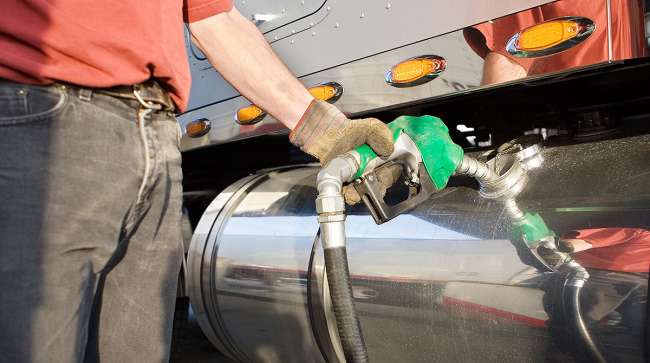Senior Reporter
Diesel Slides Again, Down 3.5¢ to $3.07 a Gallon

[Stay on top of transportation news: Get TTNews in your inbox.]
The U.S. average retail price of diesel dropped 3.5 cents to $3.07 a gallon, the Department of Energy reported June 17.
Crude oil prices initially slipped below $52 a barrel amid more warning signs of weakening demand, but later spiked to more than $56 on news that Iran shot down a U.S. spy drone, claiming it flew over Iranian territory.
The average diesel price has fallen 9.3 cents a gallon since May 20.
Diesel costs 17.4 cents less than it did a year ago when it was $3.244, DOE said.
U.S. average #diesel fuel price on 6/17/2019 was $3.070/gal, DOWN 3.5¢/gallon from 6/10/19, DOWN 17.4¢/gallon from year ago https://t.co/Sez2Yg63D3 #truckers #shippers #fuelprices pic.twitter.com/50gcQg1lzg — EIA (@EIAgov) June 18, 2019
Regional diesel fell everywhere across the nation. The regional average that fell the least: 2.3 cents in the Gulf Coast area to $2.820 a gallon.
Also, the national average price for regular gasoline dropped 6.2 cents to $2.670 a gallon, DOE’s Energy Information Administration said.
Gasoline’s national average price has fallen for six consecutive weeks, dropping a total of 19.6 cents over that period.
Gasoline inventories in the U.S. Gulf of Mexico are at the highest for the time of year since at least 1990, Bloomberg News reported.
Meanwhile, the North American Council for Freight Efficiency said 10 fleets are preparing for its Regional Run on Less event, a three-week freight efficiency roadshow starting Oct. 8 to showcase trucks operating in a variety of regional-haul applications in the United States.
Unlike the 10 mpg goal sought in the initial Run on Less event in 2017, NACFE is not forecasting a specific achievement in mpg for the regional trucks.
“There are so many more variables. We are working on a baseline to compare to,” NACFE Executive Director Mike Roeth told Transport Topics.
But automated manual transmissions, engine parameter settings, some aerodynamic devices and driver-coaching tools are likely to play prominent roles once the trucks get underway, he said.
Some of those trucks could go out 300 miles then back; or run out and back in different directions different days of the week; perform multiple drops and run fewer miles with the challenge of starting and stopping and the amount of fuel that is burned; or other trucks could go out and be out multiple nights, but stay within the 300-mile radius, Roeth said.
In addition, NACFE reported regional operations are fertile ground for alternative-fueled vehicles because by their very nature they make it easier for the necessary fueling infrastructure to be installed.
In all, 45% of the Class 8 tractors produced are daycabs, and a high percentage of those trucks are involved in regional haul operations, according to the group.
The Environmental Protection Agency on July 9 is scheduled to hold a webinar that will recognize the role and growth of regional trucking by expanding its SmartWay program to include daycabs.
Speaking of the attack on the drone and the surge in oil prices, Phil Flynn, an oil analyst with the Price Futures Group of Chicago, said, “Near term, I think it was a catalyst to break the down trend we’ve had since the Memorial Day period. The bearish people got really bearish, and now everything is turning against them on the fundamentals front.”
As a result of the rising tensions, Flynn said oil could “rally significantly” and may climb, soon, to $60 a barrel. If that happens diesel prices are certain to climb, too.
Longer-term factors, he said, are also set to drive crude prices higher, including the possibility of a cut in interest rates, and EIA’s report on demand was better than expected. “We have an environment that’s actually pretty bullish.”
EIA reported U.S. commercial crude oil inventories for the week ending June 14 decreased by 3.1 million barrels from the previous week.
West Texas Intermediate crude futures on the New York Mercantile Exchange closed at $51.74 on June 17 compared with $53.26 per barrel June 10.
Oil had slipped further into a bear market as American factories and homebuilders offered the latest warning signs of weakening demand.
#TodayInEnergy - The Strait of #Hormuz is the world's most important #oil transit chokepoint https://t.co/9gfb8rLkRG #OilTankers #EnergyTrade pic.twitter.com/IlJi0nom2M — EIA (@EIAgov) June 20, 2019
The decline came despite signs the OPEC+ producer alliance was inching closer to a gathering to formally extend production cuts. Iran, the lone holdout, is willing to meet in late June or mid-July, Oil Minister Bijan Namdar Zanganeh told reporters in Tehran on June 17, although a final date still wasn’t set, Bloomberg reported.
Then Iran’s Revolutionary Guard shot down a U.S. surveillance drone June 20 in the Strait of Hormuz, and WTI crude futures jumped to $56.68 at noon June 20.
“Geopolitics is helping oil bulls to make a spectacular comeback after a few days of directionless trading,” Tamas Varga, an analyst at PVM Oil Associates Ltd. in London, told Bloomberg.




